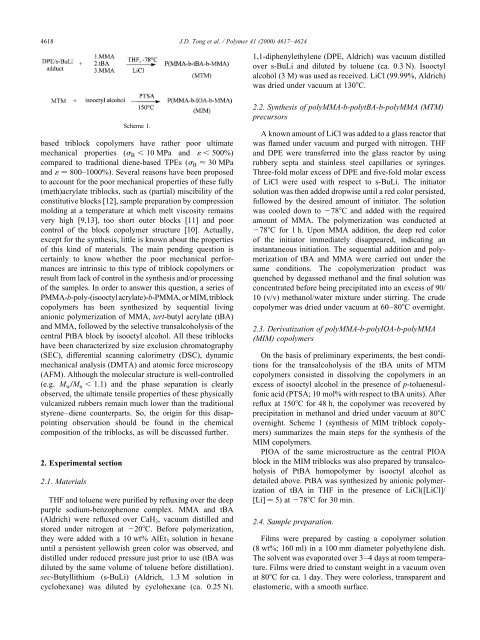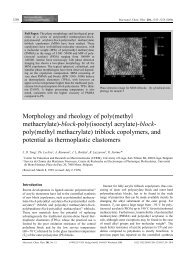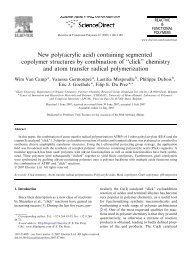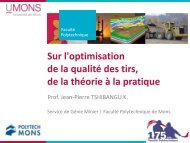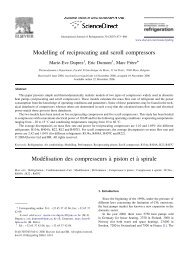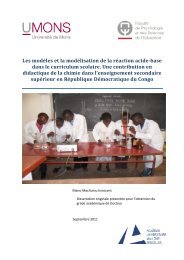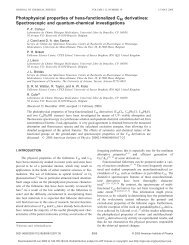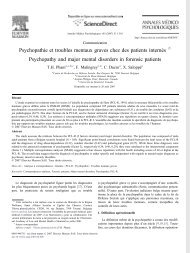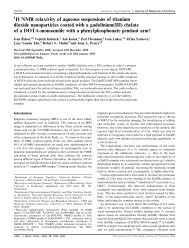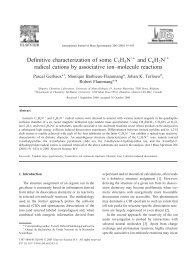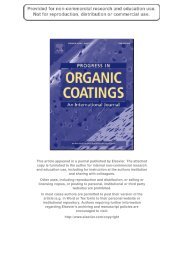Synthesis and bulk properties of poly(methyl methacrylate)-b- poly ...
Synthesis and bulk properties of poly(methyl methacrylate)-b- poly ...
Synthesis and bulk properties of poly(methyl methacrylate)-b- poly ...
You also want an ePaper? Increase the reach of your titles
YUMPU automatically turns print PDFs into web optimized ePapers that Google loves.
4618<br />
J.D. Tong et al. / Polymer 41 (2000) 4617–4624<br />
1,1-diphenylethylene (DPE, Aldrich) was vacuum distilled<br />
over s-BuLi <strong>and</strong> diluted by toluene (ca. 0.3 N). Isooctyl<br />
alcohol (3 M) was used as received. LiCl (99.99%, Aldrich)<br />
was dried under vacuum at 130C.<br />
based triblock co<strong>poly</strong>mers have rather poor ultimate<br />
mechanical <strong>properties</strong> (s B 10 MPa <strong>and</strong> 1 500%)<br />
compared to traditional diene-based TPEs (s B 30 MPa<br />
<strong>and</strong> 1 800–1000%). Several reasons have been proposed<br />
to account for the poor mechanical <strong>properties</strong> <strong>of</strong> these fully<br />
(meth)acrylate triblocks, such as (partial) miscibility <strong>of</strong> the<br />
constitutive blocks [12], sample preparation by compression<br />
molding at a temperature at which melt viscosity remains<br />
very high [9,13], too short outer blocks [11] <strong>and</strong> poor<br />
control <strong>of</strong> the block co<strong>poly</strong>mer structure [10]. Actually,<br />
except for the synthesis, little is known about the <strong>properties</strong><br />
<strong>of</strong> this kind <strong>of</strong> materials. The main pending question is<br />
certainly to know whether the poor mechanical performances<br />
are intrinsic to this type <strong>of</strong> triblock co<strong>poly</strong>mers or<br />
result from lack <strong>of</strong> control in the synthesis <strong>and</strong>/or processing<br />
<strong>of</strong> the samples. In order to answer this question, a series <strong>of</strong><br />
PMMA-b-<strong>poly</strong>-(isooctyl acrylate)-b-PMMA, or MIM, triblock<br />
co<strong>poly</strong>mers has been synthesized by sequential living<br />
anionic <strong>poly</strong>merization <strong>of</strong> MMA, tert-butyl acrylate (tBA)<br />
<strong>and</strong> MMA, followed by the selective transalcoholysis <strong>of</strong> the<br />
central PtBA block by isooctyl alcohol. All these triblocks<br />
have been characterized by size exclusion chromatography<br />
(SEC), differential scanning calorimetry (DSC), dynamic<br />
mechanical analysis (DMTA) <strong>and</strong> atomic force microscopy<br />
(AFM). Although the molecular structure is well-controlled<br />
(e.g. M w =M n 1:1) <strong>and</strong> the phase separation is clearly<br />
observed, the ultimate tensile <strong>properties</strong> <strong>of</strong> these physically<br />
vulcanized rubbers remain much lower than the traditional<br />
styrene–diene counterparts. So, the origin for this disappointing<br />
observation should be found in the chemical<br />
composition <strong>of</strong> the triblocks, as will be discussed further.<br />
2. Experimental section<br />
2.1. Materials<br />
Scheme 1.<br />
THF <strong>and</strong> toluene were purified by refluxing over the deep<br />
purple sodium-benzophenone complex. MMA <strong>and</strong> tBA<br />
(Aldrich) were refluxed over CaH 2 , vacuum distilled <strong>and</strong><br />
stored under nitrogen at 20C. Before <strong>poly</strong>merization,<br />
they were added with a 10 wt% AlEt 3 solution in hexane<br />
until a persistent yellowish green color was observed, <strong>and</strong><br />
distilled under reduced pressure just prior to use (tBA was<br />
diluted by the same volume <strong>of</strong> toluene before distillation).<br />
sec-Butyllithium (s-BuLi) (Aldrich, 1.3 M solution in<br />
cyclohexane) was diluted by cyclohexane (ca. 0.25 N).<br />
2.2. <strong>Synthesis</strong> <strong>of</strong> <strong>poly</strong>MMA-b-<strong>poly</strong>tBA-b-<strong>poly</strong>MMA (MTM)<br />
precursors<br />
A known amount <strong>of</strong> LiCl was added to a glass reactor that<br />
was flamed under vacuum <strong>and</strong> purged with nitrogen. THF<br />
<strong>and</strong> DPE were transferred into the glass reactor by using<br />
rubbery septa <strong>and</strong> stainless steel capillaries or syringes.<br />
Three-fold molar excess <strong>of</strong> DPE <strong>and</strong> five-fold molar excess<br />
<strong>of</strong> LiCl were used with respect to s-BuLi. The initiator<br />
solution was then added dropwise until a red color persisted,<br />
followed by the desired amount <strong>of</strong> initiator. The solution<br />
was cooled down to 78C <strong>and</strong> added with the required<br />
amount <strong>of</strong> MMA. The <strong>poly</strong>merization was conducted at<br />
78C for 1 h. Upon MMA addition, the deep red color<br />
<strong>of</strong> the initiator immediately disappeared, indicating an<br />
instantaneous initiation. The sequential addition <strong>and</strong> <strong>poly</strong>merization<br />
<strong>of</strong> tBA <strong>and</strong> MMA were carried out under the<br />
same conditions. The co<strong>poly</strong>merization product was<br />
quenched by degassed methanol <strong>and</strong> the final solution was<br />
concentrated before being precipitated into an excess <strong>of</strong> 90/<br />
10 (v/v) methanol/water mixture under stirring. The crude<br />
co<strong>poly</strong>mer was dried under vacuum at 60–80C overnight.<br />
2.3. Derivatization <strong>of</strong> <strong>poly</strong>MMA-b-<strong>poly</strong>IOA-b-<strong>poly</strong>MMA<br />
(MIM) co<strong>poly</strong>mers<br />
On the basis <strong>of</strong> preliminary experiments, the best conditions<br />
for the transalcoholysis <strong>of</strong> the tBA units <strong>of</strong> MTM<br />
co<strong>poly</strong>mers consisted in dissolving the co<strong>poly</strong>mers in an<br />
excess <strong>of</strong> isooctyl alcohol in the presence <strong>of</strong> p-toluenesulfonic<br />
acid (PTSA; 10 mol% with respect to tBA units). After<br />
reflux at 150C for 48 h, the co<strong>poly</strong>mer was recovered by<br />
precipitation in methanol <strong>and</strong> dried under vacuum at 80C<br />
overnight. Scheme 1 (synthesis <strong>of</strong> MIM triblock co<strong>poly</strong>mers)<br />
summarizes the main steps for the synthesis <strong>of</strong> the<br />
MIM co<strong>poly</strong>mers.<br />
PIOA <strong>of</strong> the same microstructure as the central PIOA<br />
block in the MIM triblocks was also prepared by transalcoholysis<br />
<strong>of</strong> PtBA homo<strong>poly</strong>mer by isooctyl alcohol as<br />
detailed above. PtBA was synthesized by anionic <strong>poly</strong>merization<br />
<strong>of</strong> tBA in THF in the presence <strong>of</strong> LiCl([LiCl]/<br />
[Li] ˆ 5) at 78C for 30 min.<br />
2.4. Sample preparation.<br />
Films were prepared by casting a co<strong>poly</strong>mer solution<br />
(8 wt%; 160 ml) in a 100 mm diameter <strong>poly</strong>ethylene dish.<br />
The solvent was evaporated over 3–4 days at room temperature.<br />
Films were dried to constant weight in a vacuum oven<br />
at 80C for ca. 1 day. They were colorless, transparent <strong>and</strong><br />
elastomeric, with a smooth surface.


